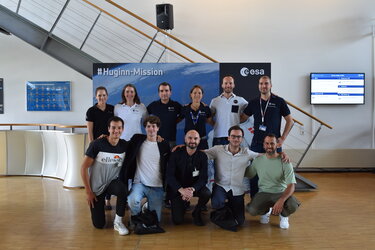Accept all cookies Accept only essential cookies See our Cookie Notice

About ESA
The European Space Agency (ESA) is Europe’s gateway to space. Its mission is to shape the development of Europe’s space capability and ensure that investment in space continues to deliver benefits to the citizens of Europe and the world.
Highlights
ESA - United space in Europe
This is ESA ESA facts Member States & Cooperating States Funding Director General Top management For Member State Delegations European vision European Space Policy ESA & EU Space Councils Responsibility & Sustainability Annual Report Calendar of meetings Corporate newsEstablishments & sites
ESA Headquarters ESA ESTEC ESA ESOC ESA ESRIN ESA EAC ESA ESAC Europe's Spaceport ESA ESEC ESA ECSAT Brussels Office Washington OfficeWorking with ESA
Business with ESA ESA Commercialisation Gateway Law at ESA Careers Cyber resilience at ESA IT at ESA Newsroom Partnerships Merchandising Licence Education Open Space Innovation Platform Integrity and Reporting Administrative Tribunal Health and SafetyMore about ESA
History ESA Historical Archives Exhibitions Publications Art & Culture ESA Merchandise Kids Diversity ESA Brand Centre ESA ChampionsSpace in Member States
Find out more about space activities in our 23 Member States, and understand how ESA works together with their national agencies, institutions and organisations.
Science & Exploration
Exploring our Solar System and unlocking the secrets of the Universe
Go to topicAstronauts
Missions
Juice Euclid Webb Solar Orbiter BepiColombo Gaia ExoMars Cheops Exoplanet missions More missionsActivities
International Space Station Orion service module Gateway Concordia Caves & Pangaea BenefitsLatest
Space Safety
Protecting life and infrastructure on Earth and in orbit
Go to topicAsteroids
Asteroids and Planetary Defence Asteroid danger explained Flyeye telescope: asteroid detection Hera mission: asteroid deflection Near-Earth Object Coordination CentreSpace junk
About space debris Space debris by the numbers Space Environment Report In space refuelling, refurbishing and removingSafety from space
Clean Space ecodesign Zero Debris Technologies Space for Earth Supporting Sustainable DevelopmentApplications
Using space to benefit citizens and meet future challenges on Earth
Go to topicObserving the Earth
Observing the Earth Future EO Copernicus Meteorology Space for our climate Satellite missionsCommercialisation
ESA Commercialisation Gateway Open Space Innovation Platform Business Incubation ESA Space SolutionsLatest
Enabling & Support
Making space accessible and developing the technologies for the future
Go to topicBuilding missions
Space Engineering and Technology Test centre Laboratories Concurrent Design Facility Preparing for the future Shaping the Future Discovery and Preparation Advanced Concepts TeamSpace transportation
Space Transportation Ariane Vega Space Rider Future space transportation Boost! Europe's Spaceport Launches from Europe's Spaceport from 2012Latest

Spacesuit design: Oussama Guarraz
Thank you for liking
You have already liked this page, you can only like it once!
One of the winning designs selected by the jury of ESA’s Space Suit Design Competition. The competition collected ideas from the public on what a future European extra-vehicular activity (EVA) suit could look like. This design was made by Oussama Guarraz.
Taking into account the extreme conditions spacewalk suits must withstand to protect our astronauts, participants were challenged to design a suit that is instantly recognisable for ESA astronauts. Over 90 ideas were received, and an ESA jury of exploration experts reviewed these proposals and ultimately selected five winners:
“The design of our future spacesuit for the European Space Agency centres around the notion of European identity and some of its key values: modernity, cutting-edge technology, innovation, and sustainability,” writes Oussama in his proposal.
“The choice of colour for our spacesuit focuses on a palette of bright and modern colours, including electric blue, bright white, and silver grey. We chose this combination of colours to convey a message of high technology and clarity. We also added geometric patterns on the spacesuit to create a unique texture, inspired by European art designs. These motifs add a touch of elegance and originality to the spacesuit while recalling the importance of art and culture in the European identity.”
Oussama also mentions technical elements: “The helmet has an advanced ventilation system to ensure comfortable and efficient breathing. The solar panels on the combination generate solar energy, reducing the use of disposable batteries and increasing ESA’s commitment to sustainability and the environment.”
-
CREDIT
ESA -
LICENCE
ESA Standard Licence

Spacesuit design: João Montenegro

Spacesuit design: Flavio Gentile

Spacesuit design: Alberto Piovesan

ESA's spacesuit design competition winners and ESA a…















 Germany
Germany
 Austria
Austria
 Belgium
Belgium
 Denmark
Denmark
 Spain
Spain
 Estonia
Estonia
 Finland
Finland
 France
France
 Greece
Greece
 Hungary
Hungary
 Ireland
Ireland
 Italy
Italy
 Luxembourg
Luxembourg
 Norway
Norway
 The Netherlands
The Netherlands
 Poland
Poland
 Portugal
Portugal
 Czechia
Czechia
 Romania
Romania
 United Kingdom
United Kingdom
 Slovenia
Slovenia
 Sweden
Sweden
 Switzerland
Switzerland
























